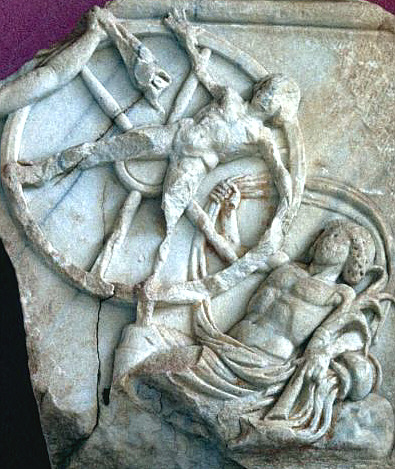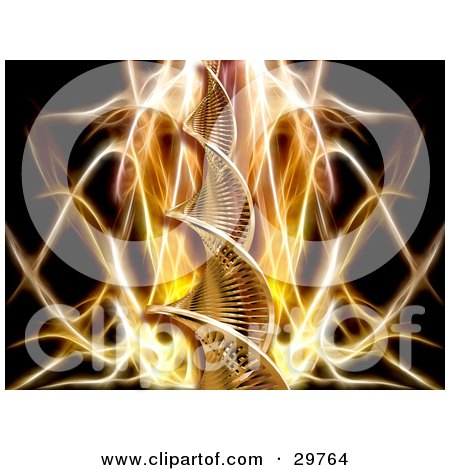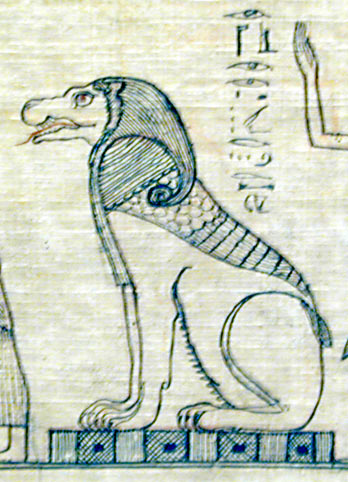
WHEEL=SPIRAL
Though little information survives about him, Ixion is a fundamental character in Greek mythology. The most complete account of Ixion's tale
comes from Pindar in his Pythian Odes. Ixion was the son the Phlegyas,
descendent of Ares,
and king of the Lapiths in
Thessaly. He is significant in many respects, but is chiefly known as
the first human to shed kindred blood. This occurred when Ixion invited
his father-in-law, Deioneus, to come and collect the price that Ixion
owed him for his bride. Upon his arrival, Deioneus fell into a pit
filled with burning coals Ixion had camouflaged.
Because this was a crime new to the human race, nobody could purify Ixion and he wandered an exile. Zeus took pity
on him and decided not only to purify Ixion, but to invite him to
Olympus as a guest. Once in Olympus though, Ixion became so enamored of Hera, and he
desired to sleep with her. Zeus did not believe that Ixion would be so
disrespectful as to have designs upon the wife of his host. To see if
the rumors were true, Zeus made an image of Hera out of a cloud, and
impregnated it. The cloud bore Ixion the monster Centaurus, who was
unloved by the Graces
and had no honor among men or the gods. Centaurus then mated with the
mares of Mt. Pelion in Magnesia, and so from Ixion the race of centaurs
was born.
To punish him, Zeus bound Ixion to a winged (sometimes flaming) wheel, which revolved in the air in all directions. Also, by order of the gods,
Ixion was forced to call out continuously call out: "You should show
gratitude to your benefactor." Ixion became one of the more famous
sinners on display on Tartarus, and most writers mention him when
describing the place. For example, Ovid wrote of him, and Vergil, with
his moralistic interpretation of how sin should be punished, awards
Ixion a special mention in the Aenead.
The focus of Ixion's mythology on the guest/host relationship shows the venerable age of Ixion's story. Of all the attributes Zeus became
associated with, he was originally particularly worried that the custom
of Xenia, the formal institution of friendship that ensured traveling
archaic Greeks could count on each other for safety in antiquity, be
enforced (for more on this in all the Greek world see Powell 150; the
importance of the guest/host relationship is fundamental to all world
mythology, take the Biblical story of Sodom and Gommorah, for example).
Aeschylus remembered Ixion's role as the purified progenitor of blood guilt in the Euminides. Athena, before
she will hear Orestes'
case refers to him as Ixion, an allusion Orestes balks at and tries to
convince her is false (Euminides. 450-455).
Pirithous, king of the Lapiths, good friend of Theseus, and
important in later myth, is considered to be one of Ixion's children.
There is another claimant to Pirithous' paternity though. Zeus, in the Iliad
14. 317-318, claims to have seduced Dia, Ixion's wife, and fathered
Pirithous.

HELIX = HELL-IX=HELL FIRE 9 (THE DOWNWARD SPIRAL)
Norse mythology, Lævateinn is a weapon mentioned in the Poetic Edda poem Fjölsvinnsmál. The name Lævateinn
does not appear in the original manuscript reading, but is an emendation
from Hævateinn made by Sophus
Bugge and others. The amended name Lævateinn is
etymologically considered to be a kenning
for a sword ( Norse"">Old Norse "damage twig"[1])
Norse mythology, Lævateinn is a weapon mentioned in the Poetic Edda poem Fjölsvinnsmál. The name Lævateinn
does not appear in the original manuscript reading, but is an emendation
from Hævateinn made by Sophus
Bugge and others. The amended name Lævateinn is
etymologically considered to be a kenning
for a sword ( Norse"">Old Norse "damage twig"[1])

| Benjamin Thorpe's translation: |
|
the name Lopt, refers to Loki.[
9 LOCKS FASTEN IT FIRM


Tiberian Liwyāṯān ;
"twisted, coiled"), is a sea
monster referred to in the Tanakh and
the Bible.
In Demonology, Leviathan is one of the seven princes of Hell and its
gatekeeper (see Hellmouth).
TWISTED, COILED
DANTE'S INFERNO 9(IX) CIRCLES OF HELL -- HEL-IX
HELLMOUTH
AMMUT THE DEVOURER
This detail scene from the Papyrus of Hunefer (ca. 1375 B.C.) shows Hunefer's heart being weighed on the scale of Maat against the feather of truth, by the jackal-headed Anubis. The Ibis-headed Thoth, scribe of the gods, records the result. If his heart is lighter than the feather, Hunefer is allowed to pass into the afterlife. If not, he is eaten by the waiting Ammit.
In the Hall of Two Truths, Anubis weighed the heart of a person against Ma'at, the goddess of truth, who was sometimes depicted symbolically as an ostrich feather. If the heart was judged to be not pure, Ammit would devour it, and the person undergoing judgement was not allowed to continue their voyage towards Osiris and immortality. Once Ammut swallowed the heart, the soul was believed to become restless forever; this was called "to die a second time". Ammit was also sometimes said to stand by a lake of fire. In some traditions, the unworthy hearts were cast into the fiery lake to be destroyed. Some scholars believe Ammit and the lake represent the same concept of destruction.





No comments:
Post a Comment